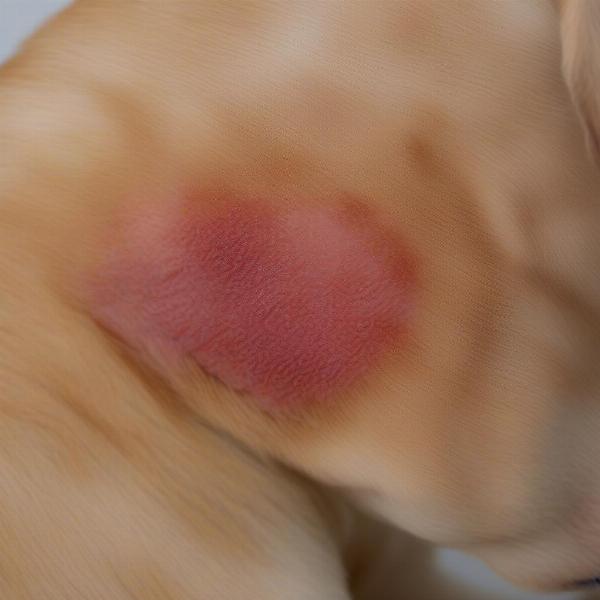Brush burn in dogs, while often overlooked, can cause significant discomfort and skin irritation. This comprehensive guide will help you understand what brush burn is, how to identify it, and most importantly, how to treat and prevent it in your canine companion. From choosing the right brush to practicing proper grooming techniques, we’ll cover everything you need to know to keep your dog’s skin healthy and happy.
What is Brush Burn on a Dog?
Brush burn occurs when excessive or improper brushing irritates a dog’s skin, causing redness, inflammation, and sometimes even minor abrasions. It’s often a result of using brushes with bristles that are too harsh, applying too much pressure while brushing, or brushing too frequently, especially in sensitive areas. While any dog can experience brush burn, those with thin coats, sensitive skin, or underlying skin conditions are more susceptible.
 Dog with brush burn on skin
Dog with brush burn on skin
Identifying Brush Burn in Your Dog
Recognizing brush burn early is crucial for effective treatment. Look for these telltale signs:
- Redness and inflammation: The affected area will appear red and may be slightly swollen.
- Sensitivity to touch: Your dog may flinch or whine when you touch the area.
- Hair loss: In severe cases, brush burn can lead to hair loss in the affected area.
- Small scabs or abrasions: If the burn is severe, you may see small scabs or open sores.
Treating Brush Burn on Your Dog
If you suspect your dog has brush burn, the first step is to stop brushing the affected area immediately. Then, follow these steps to help your dog heal:
- Soothe the skin: Apply a cool compress to the area for 10-15 minutes several times a day. This will help reduce inflammation and soothe the irritated skin.
- Use a gentle cleanser: Clean the area with a mild, hypoallergenic dog shampoo and lukewarm water. Avoid harsh soaps or chemicals.
- Apply a topical ointment: Consult your veterinarian about using a soothing ointment or spray specifically designed for dogs to promote healing and prevent infection.
- Prevent further irritation: Keep your dog from licking or scratching the area. You may need to use an Elizabethan collar (cone) to prevent this.
Preventing Brush Burn
Prevention is always better than cure. Here are some tips to prevent brush burn in your dog:
- Choose the right brush: Select a brush appropriate for your dog’s coat type. Avoid brushes with stiff or metal bristles, especially for dogs with sensitive skin.
- Use proper brushing technique: Brush gently in the direction of hair growth. Avoid applying excessive pressure or pulling on the hair.
- Brush regularly, but not excessively: Regular brushing helps prevent mats and tangles, but over-brushing can lead to irritation. Adjust your brushing frequency based on your dog’s breed and coat type.
- Check your dog’s skin regularly: Regularly inspect your dog’s skin for any signs of redness, irritation, or other abnormalities.
What if the Brush Burn Doesn’t Heal?
If your dog’s brush burn doesn’t improve within a few days or if it appears to be getting worse, consult your veterinarian. They can determine if there’s an underlying skin condition or infection and recommend appropriate treatment.
Conclusion
Brush burn is a common but preventable skin irritation in dogs. By understanding the causes, symptoms, and treatment options, you can keep your furry friend comfortable and healthy. Remember to choose the right brush, practice proper grooming techniques, and monitor your dog’s skin regularly to prevent brush burn. For specific advice related to your dog’s breed and coat, consult a professional groomer or your veterinarian.
FAQs
- What does dog brush burn look like? Brush burn appears as red, irritated skin, sometimes with slight swelling. In severe cases, there may be hair loss or small scabs.
- How do you treat brush burn on a dog? Stop brushing the area, apply cool compresses, clean with a gentle cleanser, and consult your vet about topical ointments.
- What kind of brush is best for dogs with sensitive skin? Soft-bristled brushes, slicker brushes, or grooming gloves are generally recommended for sensitive skin.
- How often should I brush my dog? Brushing frequency depends on breed and coat type. Consult a groomer or vet for personalized advice.
- Can brush burn get infected? Yes, if left untreated, brush burn can become infected. Consult your vet if you see signs of infection, such as pus or increased redness.
- How long does it take for brush burn to heal on a dog? With proper care, mild brush burn usually heals within a few days. Severe cases may take longer.
- Is it okay to use human lotion on dog brush burn? No, it’s best to avoid using human products on dogs as they may contain ingredients that are harmful to them. Consult your vet for recommendations.
ILM Dog is a leading international online resource for dog owners, offering expert advice on dog breeds, health, training, nutrition, grooming, and more. We provide practical, trustworthy information to help you provide the best possible care for your canine companion. Whether you’re a new dog owner or a seasoned expert, ILM Dog is your go-to source for all things dog-related. For further assistance or personalized advice, please contact us at [email protected] or +44 20-3965-8624. Visit us at ILM Dog for more information on dog clipper, dog brush for Siberian husky and Newfoundland dog shaved. We also have an interesting article about engagement photoshoot with dog, should you decide to include your furry friend in your special moments!